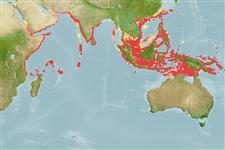Environment: milieu / climate zone / depth range / distribution range
นิเวศวิทยา
เกี่ยวกับทะเล,น้ำเค็ม เกี่ยวกับหินโสโครก; ระดับความลึก 24 - 90 m (Ref. 11441). Tropical; 27°N - 13°S, 39°E - 158°E (Ref. 5222)
Indo-West Pacific: Gulf of Oman to Kenya, including Laccadive Islands, India, Sri Lanka, and the Andaman Islands. Not reported in the Red Sea and Persian Gulf. Known also from Indonesia, Sarawak of Malaysia, New Guinea, Papua New Guinea, Solomon Islands, and the Philippines.
Length at first maturity / ขนาด / น้ำหนัก / Age
Maturity: Lm ?, range 41 - ? cm
Max length : 120 cm TL เพศผู้/กระเทย; (Ref. 89707); common length : 45.0 cm TL เพศผู้/กระเทย; (Ref. 5450); น้ำหนักสูงสุดที่มีการรายงาน: 6.4 kg (Ref. 5222)
เงี่ยงครีบหลัง (รวม): 11; ก้านครีบอ่อนที่หาง (รวม): 17-19; เงี่ยงครีบก้น 3; ก้านครีบอ่อนที่ก้น: 8. Distinguished by the following characteristics: head, body and fins purplish grey to brownish grey; head with brown to golden brown dots and wavy longitudinal lines of the same colour on the dorsal part of the body (lines faint of absent on large specimens); narrowly blackish margin of spinous dorsal fin; body depth contained 2.7-3.1 times in SL; head length 2.5-2.7 times in SL; convex interorbital area; angular preopercle, notch above angle and enlarged serrae at angle; straight or slightly concave upper edge of operculum; subequal posterior and anterior nostrils or slightly larger posterior nostril; maxilla reaches to vertical at rear edge of eye; ventral edge of maxilla in adults with prominent knob or hook-like process; 2 rows of teeth on midlateral part of lower jaw (Ref. 89707).
Lives on muddy open substrate, seeking refuge in holes in the mud or with solid structures, shipwrecks or debris. A flighty species (Ref; 48635). Also found on banks (Ref. 5222). Feeds on small fishes and crustaceans (stomatopods), shrimps, and pelagic tunicates (Thalia and Pyrosoma sp.) (Ref. 5222). Solitary (Ref 90102).
Life cycle and mating behavior
วัยเจริญพันธุ์ | การสืบพันธุ์ | การวางไข่ | เซลสืบพันธ์ของเพศเมีย(ไข่) | ความดกของไข่ | ตัวอ่อน
Heemstra, P.C. and J.E. Randall, 1993. FAO Species Catalogue. Vol. 16. Groupers of the world (family Serranidae, subfamily Epinephelinae). An annotated and illustrated catalogue of the grouper, rockcod, hind, coral grouper and lyretail species known to date. Rome: FAO. FAO Fish. Synop. 125(16):382 p. (Ref. 5222)
IUCN Red List Status (Ref. 130435)
Threat to humans
Harmless
Human uses
การประมง: มีการค้าเพียงเล็กน้อย
ข้อมูลเพิ่มเติม
ชื่อสามัญชื่อพ้องกลไกการเผาผลาญพลังงานผู้ล่าการศึกษาเกี่ยวกับผลกระทบของสารประกอบทางเคมีที่เป็นอันตรายต่อสิ่งมีชีวิต ประชากร และสิ่งแวดล้อมการสืบพันธุ์วัยเจริญพันธุ์การวางไข่การรวมกลุ่มวางไข่ความดกของไข่เซลสืบพันธ์ของเพศเมีย(ไข่)Egg development
อ้างอิงการเพาะเลี้ยงสัตว์น้ำประวัติการเพาะเลี้ยงสัตว์น้ำสายพันธุ์พันธุศาสตร์ElectrophoresesอัตราพันธุกรรมโรคการแปรรูปNutrientsMass conversion
ผู้ร่วมมือรูปภาพหลายรูปStamps, Coins Misc.เสียงปลามีพิษ เช่น ปลาปักเป้าความเร็วรูปแบบการว่ายน้ำพื้นที่เหงือกOtolithsสมองวิสัยทัศน์
เครื่องมือ
Special reports
Download XML
แหล่งที่มาจากอินเตอร์เน็ต
Estimates based on models
Preferred temperature (Ref.
123201): 23.9 - 28.6, mean 27.5 °C (based on 499 cells).
Phylogenetic diversity index (Ref.
82804): PD
50 = 0.5000 [Uniqueness, from 0.5 = low to 2.0 = high].
Bayesian length-weight: a=0.00724 (0.00423 - 0.01239), b=2.93 (2.79 - 3.07), in cm total length, based on LWR estimates for this species & Genus-body shape (Ref.
93245).
ระดับชั้นอาหาร (Ref.
69278): 3.7 ±0.51 se; based on food items.
ความสามารถในการกลับคืนสู่ปกติ (Ref.
120179): ต่ำมาก, เวลาต่ำสุดที่จะทำให้ประชากรเพิ่มขึ้นเป็น 2 เท่าใช้เวลามากกว่า 14 ปี (Preliminary K or Fecundity.).
Fishing Vulnerability (Ref.
59153): High to very high vulnerability (72 of 100).
